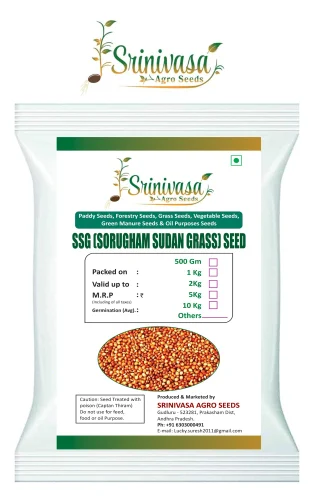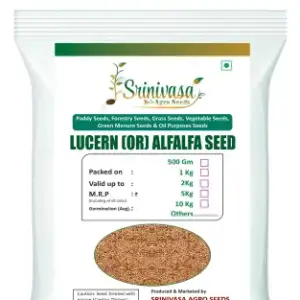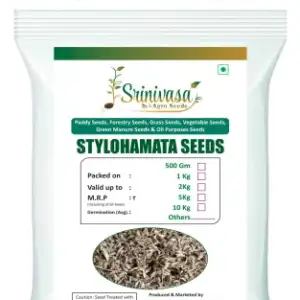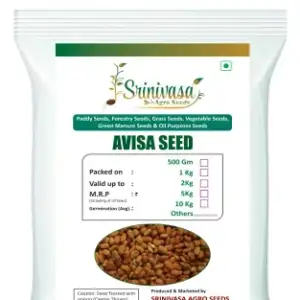Description
About Sorghum Fodder:
-
Sorghum is also an important feed component of dairy cattle and poultry feed.
-
Sorghum is a rich source of starch, protein and edible oil.
-
Sorghum produces good quality herbaceous fodder with high palatability.
-
Hence by providing sufficient quantities of fodder instead of costly concentrates and feeds to the milch animals, the cost of milk production can considerably be reduced.
-
Optimal growth conditions are 18-21°C average day-temperatures, annual rainfalls of more than 750 mm, and deep, well-drained rich soils.
-
However, Sorghum withstands annual rainfalls ranging from 230 to 4100 mm, a pH between 4.3 and 8.7, and a great variety of soils.
-
Frost kills the plants.
-
Drought is detrimental at flowering as it affects pollination and impairs yields.
-
Sorghum has no tolerance to flooding.
Sorghum Fodder – Method and time of sowing
-
Sorghum requires very fertile, well drained loamy soils having pH range of 5.5 to 8.0.
-
The crop grows best on alluvial or red soils but can also by grown on well drained black soils.
-
It does not thrive well on heavy soils, saline and alkali soils.
-
After preparing a fine seed bed the crop must be sown in lines (20-30 cm apart) by using seed drill or maize planter or by kera on para method.
-
Sowing time varies from place to place.
-
Sorghum has bold seed size.
-
It requires 50-60 kg seeds depending upon size.
-
Seed should be sown in lines spaced at 30 cm.
-
For summer sowing in irrigated areas, last week of February to last week of March-April is the appropriate time.
-
Rainy season crop is sown with the beginning of rains in June-July.
-
Rabi crop is sown in October-November particularly in eastern and southern parts of the country.
-
In hills sowing is taken up in May.
Water Management for Sorghum Fodder:
-
Irrigate immediately after sowing and give life irrigation on the third day and thereafter once in 10 days.
-
The maize crop is comparatively more to sensitive to excess moist and stress.
-
It requires 5-6 irrigation at 10-12 days interval during summer season
-
Requires 3-4 irrigation at 10-12 days during Rabi
-
And 1-2 during rainy season when rainfall interval exceeds 12 days.
How to fertilize Sorghum Fodder:
-
Sorghum responds well to the application farm yard manure and compost.
-
Apply 10 tons’ farm yard manure or compost per acre one fortnight before sowing.
-
In the absence of farm yard manure, it requires 110 kg urea per acre.
-
In addition to this in two split doses. Half of the urea should be applied at the time of sowing and remaining half 25-30 days after sowing.
Weeding Management for Sorghum Fodder:
-
Weeding has to be done in the Sorghum farm as weeds rob your plants of the benefits of the fertilise you apply.
-
Hence after 30 days, weeding has to be done for the plants.
-
If necessary, second spell of weeding can be done after 45 days
-
After that, Sorghum will grow very fast and densely.
Sorghum Fodder after 60 days of planting
-
Sorghum will become robust, tufted and has a vigorous root system, developing from nodes of its creeping stolons.
-
Sorghum by this time would have grown up to 6 feets in height.
-
They will form dense thick clumps, up to 1 m across.
-
The leaves will be flat, linear, and hairy at the base, 100 cm to 120 cm long, 1 cm to 5 cm wide and bluish-green in color.
Sorghum Fodder after 75 days of planting-
Sorghum is very palatable because the stalks are tender
-
It has a wide range of adaptability so that many farmers can benefit from it.
-
Harvesting is done at intervals of 60 to 70 days.
-
The first harvest, however, is made three months from planting.
-
Then succeeding harvests are every 60 to 70 days.
-
The stalks are cut close to the ground, and in no time, new shoots or ratoon will come out.
Harvesting Sorghum Fodder:-
The crop is ready for harvest at silk stage for fodder purpose, which continues up to milk stage.
-
The early harvesting though produce good quality fodder but yield is reduced.
-
In case of late harvesting, the fodder quality is impaired
-
Sorghum yields around 160-200 quintals of green fodder per acre during rainy season and 100-120 quintals of fodder per acre during summer season.
-
Palatability increases as hard stems when fermented into silage become soft and better utilized by the dairy animals.
-
-
-
-
-











Reviews
There are no reviews yet.